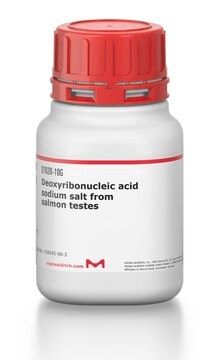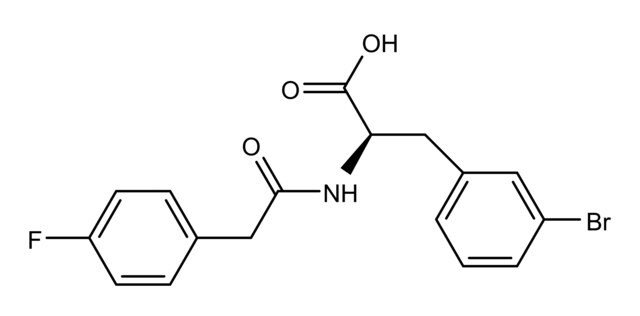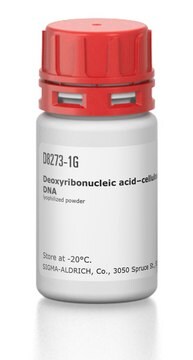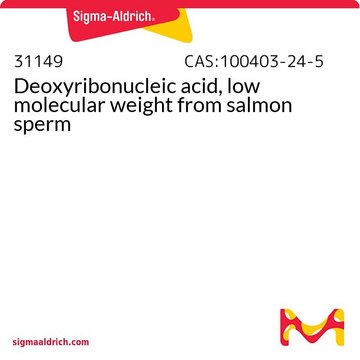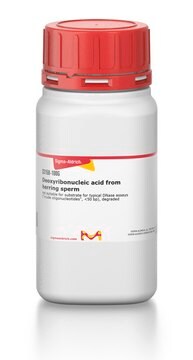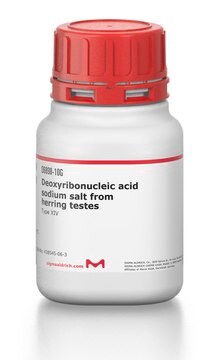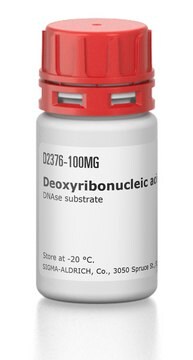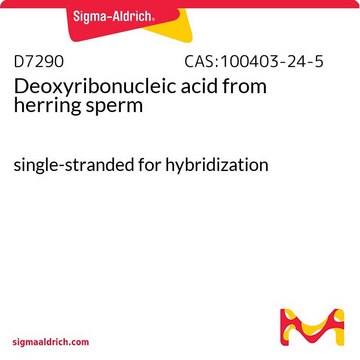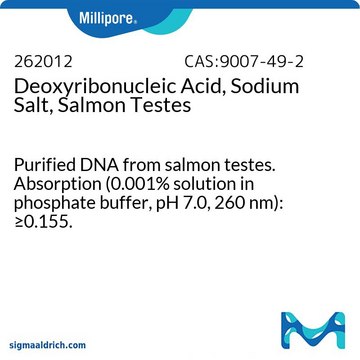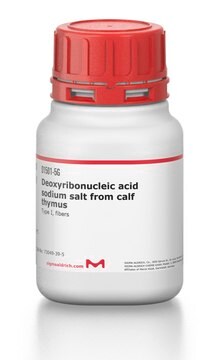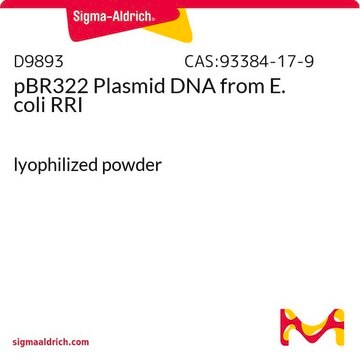D4889
Deoxyribonucleic acid sodium salt from Escherichia coli strain B
Genomic, unsheared
Synonim(y):
DNA
Zaloguj sięWyświetlanie cen organizacyjnych i kontraktowych
About This Item
Numer CAS:
Numer WE:
Numer MDL:
Kod UNSPSC:
41106310
eCl@ss:
32160414
NACRES:
NA.52
Polecane produkty
klasa czystości
Molecular Biology
for molecular biology
Poziom jakości
Formularz
lyophilized powder
masa cząsteczkowa
>45 kb
temp. przechowywania
2-8°C
Szukasz podobnych produktów? Odwiedź Przewodnik dotyczący porównywania produktów
Powiązane kategorie
Opis ogólny
Escherichia coli strain B is most widely studied DNA after k-12. The genomes of E coli strain B and k-12 show differences in the IS sequence elements. Strain B have B-islands and express O-specific side-chain LPS. The product is unsheared genomic DNA.
Specyficzność
50% GC; Tm = 90.5 °C
Zastosowanie
The DNAs are particularly useful for genomic analysis, including PCR, library construction in bacteriophage λ, and in heterologous pre-hybridization and hybridization protocols.
Deoxyribonucleic acid sodium salt from Escherichia coli strain B has been used for:
Deoxyribonucleic acid sodium salt from Escherichia coli strain B has been used for:
- PCR reactions of genomic DNA of Gardnerella vaginalis
- nick translation and radiolabeling of dNTP
- generating standard curve for 16S rDNA quantification
- transfecting neutrophils
- testing the extraction methods
Definicja jednostki
One unit will yield an A260 of 1.0 in 1.0 ml of 1 mM Tris-HCl, pH 7.5, with 1 mM NaCl and 1 mM EDTA (1 cm light path).
Uwaga dotycząca przygotowania
Purified by anion exchange chromatography, dialyzed against a solution of 1 mM sodium chloride, 1 mM EDTA and 1 mM Trizma HCl, pH 7.5 and lyophilized at a concentration of approx. 2 units per mL. Approx. 20 A260 units per mg DNA. % GC is the percentage of G/C base pairs. Tm is the temperature at the midpoint of the thermal denaturation profile.
Komentarz do analizy
Analyzed by gel electrophoresis and visualization after ethidium bromide staining, with single predominant band of 45 kB or greater.
Inne uwagi
DNA in solution will reanneal on standing at room temperature so it is recommended to boil the solution for 10 minutes and then cool on ice for at least 5 minutes prior to use.
Ta strona może zawierać tekst przetłumaczony maszynowo.
produkt powiązany
Numer produktu
Opis
Cennik
Kod klasy składowania
11 - Combustible Solids
Klasa zagrożenia wodnego (WGK)
WGK 3
Temperatura zapłonu (°F)
Not applicable
Temperatura zapłonu (°C)
Not applicable
Środki ochrony indywidualnej
Eyeshields, Gloves, type N95 (US)
Wybierz jedną z najnowszych wersji:
Masz już ten produkt?
Dokumenty związane z niedawno zakupionymi produktami zostały zamieszczone w Bibliotece dokumentów.
Klienci oglądali również te produkty
Jong-Pyo Kang et al.
Archives of microbiology, 201(1), 99-105 (2018-09-28)
A novel bacterial strain designated DCY116T was isolated from ginseng-cultivated soil in Gochang-gun, Republic of Korea. Strain DCY116T, belongs to the genus Rhizobium, and is closely related to Rhizobium yantingense H66T (98.3%), Neorhizobium huautlense S02T (98.2%), Rhizobium soli DS-42T (98.1%)
Vitalii Patsula et al.
Nanotoxicology, 13(4), 510-526 (2019-02-02)
Innovative nanotechnology aims to develop particles that are small, monodisperse, smart, and do not cause unintentional side effects. Uniform magnetic Fe3O4 nanoparticles (12 nm in size) were prepared by thermal decomposition of iron(III) oleate. To make them colloidally stable and dispersible
S Farzaneh et al.
The Journal of antimicrobial chemotherapy, 40(6), 789-795 (1998-02-14)
Klebsiella oxytoca strain HB60 is highly resistant to cefoperazone and aztreonam (MICs = 128 mg/L). It produces a chromosomally encoded beta-lactamase of pI 5.7 which was highly efficient against penicillins, first-generation cephalosporins and cefoperazone, a non-oxyimino third-generation cephalosporin. Aztreonam and
Xuewen Pan et al.
Methods (San Diego, Calif.), 41(2), 206-221 (2006-12-27)
Analysis of genetic interactions has been extensively exploited to study gene functions and to dissect pathway structures. One such genetic interaction is synthetic lethality, in which the combination of two non-lethal mutations leads to loss of organism viability. We have
Genomic comparisons among Escherichia coli strains B, K-12, and O157: H7 using IS elements as molecular markers
Schneider D, et al.
BMC Microbiology, 2(1), 18-18 (2002)
Nasz zespół naukowców ma doświadczenie we wszystkich obszarach badań, w tym w naukach przyrodniczych, materiałoznawstwie, syntezie chemicznej, chromatografii, analityce i wielu innych dziedzinach.
Skontaktuj się z zespołem ds. pomocy technicznej